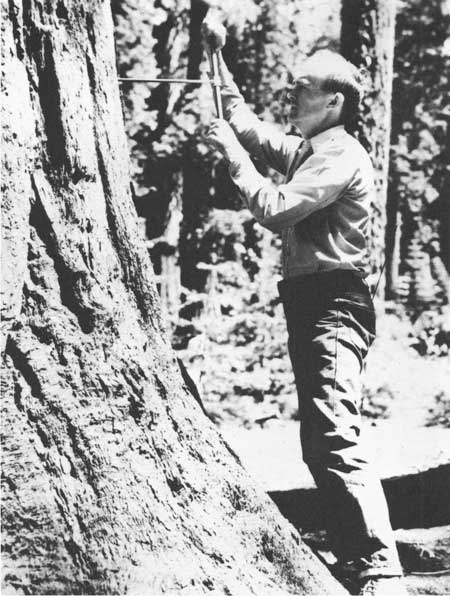|
NATIONAL PARK SERVICE
Giant Sequoia Ecology: Fire and Reproduction |

|
PREFACE
This monograph is the scientific report of a study which was carried out, in the main, in Sequoia and Kings Canyon National Parks between 1964 and 1975. Our prime concern was to examine the role of fire in the reproduction of the giant sequoia. We present detailed results on some of the ecological relationships of this species and offer them for the better management and interpretation of this majestic tree.
Our interest in this species began between 1956 and 1962 with Dr. Richard J. Hartesveldt's doctoral studies on the effects of human impact on the tree and its environment in the Mariposa Grove of Yosemite National Park. He shifted his impact studies to Sequoia-Kings Canyon National Parks in 1962, where he was initially supported by the Sequoia Natural History Association. During 1963 and 1964 he and his office partner at San Jose State University, Dr. H. Thomas Harvey, discussed the many facets of giant sequoia ecology and together formulated the general outline and goals of the present study. They concentrated on the response of vegetation to fire and, especially, the survival of giant sequoia seedlings. Dr. Howard S. Shellhammer joined Hartesveldt and Harvey in August 1964 to study vertebrates and their impact on the tree. The project received its initial funding, and the first field work was carried out in the summer of 1964. In 1966, when Dr. Ronald E. Stecker joined the research team, the scope of the study was broadened to include the potential interactions of arthropods. Dr. Stecker's earliest work was made possible by the Skelton Foundation and then, like the rest of the group, he was supported by research contracts with the National Park Service. The bulk of the field research was carried out in the summers of 1965 to 1970, plus that of 1974. The untimely death of Dr. Hartesveldt in 1975 shifted the administrative leadership of the study and the coordination of the monograph preparation to Dr. Harvey.
Before he died, Dr. Hartesveldt coordinated the writing of The Giant Sequoias of the Sierra Nevada which was submitted to the National Park Service in 1971 and published in 1975. This semi-popular publication combined many of the general results of our study with the giant sequoia lore known to Dr. Hartesveldt. Many technical reports were also generated during the period of the study. These progress and interim reports, the largest of which are those of 1965, 1967 and 1970, are on file in the Western Regional Office of the National Park Service in San Francisco and at Sequoia and Kings Canyon National Parks. Several (5) technical papers were generated by this study and are cited in the references of this monograph.
This monograph contains a comprehensive synthesis and evaluation of the scientific data from all the phases of this project plus some of Dr. Hartesveldt's 1962-64 work on environmental impact. It is the first effort to delineate, identify and evaluate the roles of fire and reproduction in the survival and perpetuation of the giant sequoia. It reports on the first prescribed management burns carried out in a national park in the West. The study was designed to examine many of the ecological relationships involved in the perpetuation of this species. We hope that it will provide park managers with an understanding of the ecology of the giant sequoias sufficient to furnish them with a scientific basis for making realistic resource management decisions. It is also designed to aid the park naturalists in their interpretation of the ecology of the giant sequoia for park visitors.

|
| Frontispiece. Dick Hartesveldt coring a giant sequoia. |
This study was not designed to study all aspects of the ecology and biology of the giant sequoia. We concentrated on fire and reproduction, while other investigators have studied fungal relationships, carpenter ants, community stability, and the giant sequoia's place in the forest mosaic, to name a few. We have referred to and briefly discussed most of these studies in the text of this monograph and refer the reader to various professional papers for more detailed information. Most of these studies have not been published but are expected to be available soon.
We have organized the monograph into ten separate chapters in a sequence of general introduction and methods, plant relationships, arthropod relationships, vertebrate relationships, and, finally, the summary and management implications. Little was really known about giant sequoia ecology before this study, so we set out to identify the principal organisms and relationships and then concentrated our studies on these. This is best seen in the arthropod and vertebrate chapters where, in each case, a first section of two is devoted to those organisms associated with some stage of the life history of the tree. In the case of the chapter on vertebrates it serves to illustrate how free the giant sequoia is of vertebrate damage and interactions. A second section follows describing the nature and effect of the interaction between insect or mammal and the tree, particularly as it involves seed production and use, or seedling survival. The overall goals of the study are presented in Chapter 2, while Chapters 3 through 9 consider special facets of the study which are then discussed in greater detail. The closing chapter deals with the management and interpretation implications of the study.
Although our studies have clarified certain ecological relationships between the giant sequoia and its environment, many intriguing questions still remain.
| <<< Previous | <<< Contents >>> | Next >>> |
preface.htm
Last Updated: 06-Mar-2007